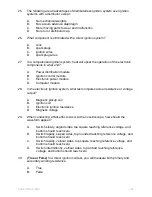
The color of wiring insulation for each trailer circuit is also standardized, as shown in
Figure 6-55
. This wiring convention should be followed to aid in troubleshooting and
identification.
SAE J560 STANDARDS
Conductor
Identification
Wire
Color
Lamp and Signal Circuits
Wht
White
Ground return to towing vehicle
Blk
Black
Clearance, side marker & license plate
Yel
Yellow
Left-hand turn signal & hazard signal lamps
Red
Red
Stop lamps and antilock devices
Grn
Green
Right-hand turn signal & hazard signal lamps
Brn
Brown
Tail, clearance, side marker lamps, &
identification lamps
Blu
Blue
Auxiliary
Figure 6-55 - Trailer standard wiring colors.
Note in the schematic layout
Figure 6-56
that the trailer running lights are broken down
into two circuits: the black wire and the brown wire. The black wire should be connected
to the front marker and clearance lamps, the identification lamp (three-bar light), the two
lower rear-side marker lamps, and the center marker lamps (if applicable). The brown
wire should be connected to the rear clearance lamps, the tail lamps, and the license
plate lamp. These circuits should be kept isolated from each other because they may be
protected by two different circuit protection devices in the tractor. Otherwise, a short
circuit at one place in the trailer running lamp wiring would disable all trailer running
lamps.
The illustration of the trailer plug and the trailer receptacle in
Figure 6-57
is something
that you should become familiar with. It shows the views of the mating end of the tractor
receptacle and of the trailer plug. A test light or a special trailer light test tool is used to
test for voltage at the specific terminal to determine if the problem is with the truck or the
trailer. Notice the larger-diameter terminal at the top; this is the trailer ground terminal.
Because all trailer light current must pass through the ground circuit, it uses a larger-
diameter terminal than the other terminals and uses a larger-diameter wire than the
other wires in the seven-way cable.
The tractor normally provides the circuit protection for trailer wiring. However, some
trailers may have circuit breakers for trailer lights as well, (
Figure-58
). The trailer power
distribution module is usually mounted on the left frame rail aft of the cab or on a rear
crossmember at the end of the frame rail, as shown in
Figure 6-59
. The trailer PDM
contains fuses and relays to enable high current outputs via a wiring harness and relays
to enable high current outputs via a wiring harness to the trailer connector.
The length of the trailer wiring must be considered when replacing trailer wiring. Even
though the rear trailer lamps may have the same ratings as the truck lamps, the long
distance to the lamps can result in a substantial voltage drop on the wiring. This
reduces the voltage at the trailer lamps. Wire gauge is especially important for double
NAVEDTRA 14050A
6-54



































